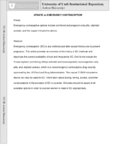|
|
Creator | Title | Description | Subject | Date |
| 26 |
 |
Caserta, Michael; Lund, Dale A.; Wright, Scott D. | Respite services: enhancing the quality of daily life for caregivers and persons with dementia | Many family caregivers are going far beyond their abilities and circumstances trying to be the best possible caregivers. This is a very commendable goal. Unfortunately, many of these caregivers are risking their own personal well-being and sometimes their family life in the process. Many caregivers... | | 2005 |
| 27 |
 |
Lund, Dale A.; Caserta, Michael; Wright, Scott D. | Restoration after bereavement | The death of a spouse in later life, after many years of marriage is one of the most common of all major stressful life transitions. After age 65, 32% of the U.S. population is widowed (14% for men and 45% for women) with this increasing to 46% after age 75 and 66% after the age of 85 (U.S. Bureau o... | Dual process model; bereavement adjustment; loss orientation | 2004 |
| 28 |
 |
Caserta, Michael; Utz, Rebecca L.; Lund, Dale A. | Sampling, recruitment, and retention in a bereavement intervention study: experiences from the living after loss project | This paper reports on the sampling and recruitment challenges, as well as the strategies used to address them in the Living After Loss (LAL) project, a bereavement intervention study conducted in Salt Lake City and San Francisco comparing two 14-week group conditions with follow-up. We encountered... | | 2010 |
| 29 |
 |
Caserta, Michael; Lund, Dale A. | Sleep patterns in older bereaved spouses | The study examined the prevalence and pattern of reports of sleep disturbance over two years in a group of 296 adults aged 50 years and over, and assessed the relationship between patterns of sleep disturbance and bereavement adjustment over time. A sample of 192 widows and widowers were compared t... | Bereavement adjustment; Older bereaved spouses; Sleep patterns; Sleep disturbance | 2003-11-01 |
| 30 |
 |
Beck, Susan L. | Symptom clusters: impediments and suggestions for solutions. | The human experience of cancer is marked by the occurrence of multiple symptoms that influence one's ability to continue usual activities and enjoy life. Although the symptom experience is complex and multifaceted, knowledge of it has been limited by a paradigm that has been singular in scope... | Cancer; Symptoms; Symptom Management; End-of-Life Care; Depression | 2004-07-21 |
| 31 |
 |
Caserta, Michael; Lund, Dale A. | Toward the development of an inventory of daily widowed life (IDWL): guided by the duel process model of coping with bereavement | The Dual Process Model of Coping with Bereavement (Stroebe & Schut, 1999) suggests that the most effective adaptation involves oscillaton between two coping processes: loss-orientation (LO) and restoration-orientation (RO). A 22-item Inventory of Daily Widowed Life (IDWL) was developed to measure t... | Bereavement; Grief reaction; Widowhood; Psychological orientation; Adaptation, Psychological | 2007-07 |
| 32 |
 |
Supiano, Katherine Perry | Transitions of care: Optimal communication between hospital and hospice | In this article, the key elements of a successful transition of terminally ill patients from the inpatient hospital to home hospice care setting are described. This article describes the role and responsibilities inpatient palliative care teams and receiving hospice agencies have for communicat... | Palliative care, Inpatient hospital; Hospice care; Transportation; Communication; Health care team | 2007 |
| 33 |
 |
Murphy, Patricia A. | Update on emergency contraception | Emergency contraception (EC) is any method used after sexual intercourse to prevent pregnancy. This article provides an overview of the history of EC methods and describes the current availability of oral and intrauterine EC. Oral forms include the Yuzpe regimen (combining ethinyl estradiol and levo... | | 2012-01-01 |
| 34 |
 |
Caserta, Michael; Lund, Dale A. | When the unexpected happens: husbands coping with the deaths of their wives | Most husbands do not outlive their wives. The 1990 Census of the United States reveals that while nearly 49 percent of women are widowed after age sixty-five only 14 percent of the men are widowed. After age eighty-five the rates of widowhood increase for both men and women. About 80 percent of thes... | | 2001 |









